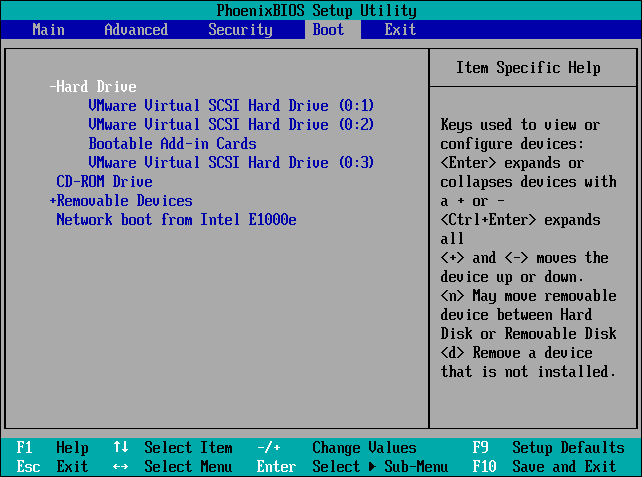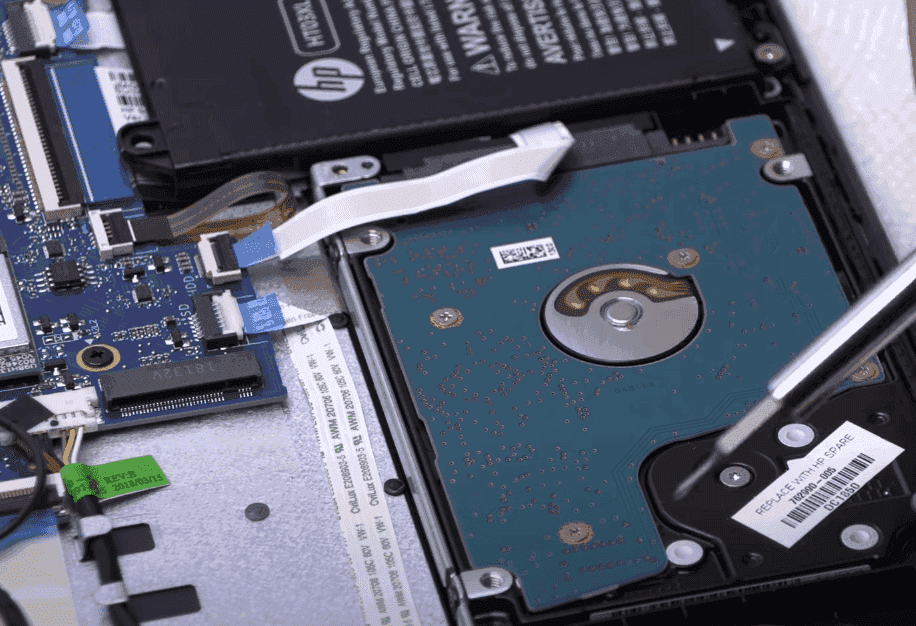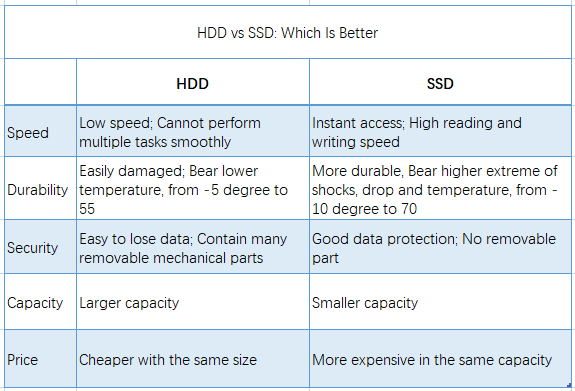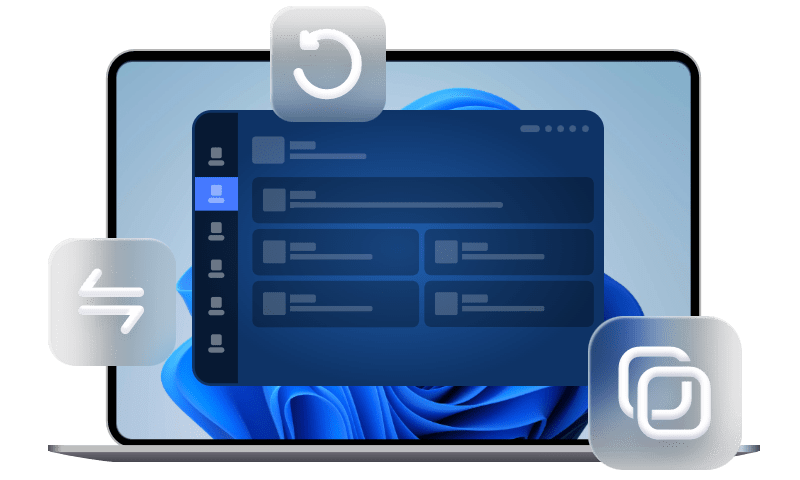Fast & Secure: Clone Hard Drive to SSD Without Losing Data in Windows 10/11
Upgrading to an SSD? Easily clone your HDD to SSD on Windows 10/11 without reinstalling the OS. This guide provides a detailed step-by-step process, along with expert tips to ensure a hassle-free migration.
How Do You Prepare for Hard Drive to SSD Cloning?
Before cloning HDD to SSD, you should:
1. Check OS and fix bad sectors
Ensure that the old HDD has an operating system (OS) installed and fix any bad sectors on it. Without an OS, you won't be able to boot your computer, and if the cloned SSD contains bad sectors from the original drive, it may not boot either.
2. Get a compatible SSD
Purchase a new SSD that is compatible with your computer's form factor and has enough space to receive your data. With the method provided in this post, it's acceptable if the new SSD is not initialized.
3. Backup old HDD
Even though you can mgirate HDD to SSD without reinstalling, creating a backup of the old disk is very important to keep your personal data safe. This backup can be used to restore your computer to its previous state if something unexpected happens during the transfer process.
4. Disconnect any external peripheral devices
You may disconnect USB storage devices, external displays, printers and the like to ensure that files are transferred from the hard drive to the SSD correctly.
5. Obtain a USB-to-SATA adapter
If your desktop/laptop has only one hard drive bay, you need to connect the new SSD via a USB-to-SATA adapter.
6. Reliable hard drive clone software
Choosing the right software is crucial. AOMEI Backupper, a powerful disk clone software with a range of advanced features and options, is recommended for copying HDD to SSD. It is fully compatible with the latest version of Windows 11.

-
Flexible cloning options: Besides cloning disks, you can migrate only the OS with System Clone or move data partitions via Partition Clone.
-
Intelligent cloning: It only copies the used sectors by default, which is very convenient to clone large HDD to smaller SSD.
-
Sector by sector clone: If your target SSD has sufficient space, you can use this option to copy all the sectors including the unused space.
-
SSD alignment: Since SSDs differ from HDDs, proper partition alignment is crucial for cloning. This option helps to optimize SSD performance and extend lifespan.
-
VSS service: With this advanced technology, you can perform a "Hot Clone", which means that the cloning process can be carried out without interrupting your work.
In addition, this hard drive cloner is compatible with all the leading brands of HDDs and SSDs, including Samsung EVO series, WD SSDs, Crucial SSDs, and more. It has gained widespread recognition from users around the world. So why not give it a try today?
How to Clone Hard Drive to SSD in Windows 10/11 (5 Steps) 🔥
🌟 Watch Our YouTube Disk Cloning Tutorial for Intuitive Instructions
- 0:00 - Start & Preparation
- 1:12 - Cloning Process
- 2:45 - Cloning FAQs
Take a look at the step-by-step instruction flowchart on how to clone HDD to SSD.
Step 1. Connect the new SSD
You have two options to connect the SSD to your PC - install it in the second drive bay or use a USB-to-SATA adapter. Make sure the capacity of the SSD is sufficient to hold all the data from the source disk.
Step 2. Choose Disk Clone in AOMEI Backupper
Install and start the disk cloning software. Then go to Clone -> Disk Clone option.
Step 3. Choose old HDD
Select the hard drive as the source disk.
Step 4. Choose new SSD
Choose the larger or smaller SSD as the destination disk.
◆ Please note that during the cloning process, all data on the destination SSD will be overwritten. Therefore, it is important to create a backup of critical data before proceeding.
Step 5. Enhance SSD performance and launch the cloning process
Tick SSD Alignment to accelerate the reading and writing speed of the SSD disk. Then, click on Start Clone to clone hard drive to SSD.
🔔How to Clone Only OS to SSD
When upgrading or replacing storage drives, advanced cloning scenarios may arise that require specialized approaches. You may need the System Clone feature of AOMEI Backupper to migrate only OS to SSD in following scenarios:
- Cloning Only the System Partition: If your SSD has limited capacity, cloning only the system partition can be an efficient solution. This approach transfers the operating system and essential files without occupying unnecessary space.
- Cloning Dynamic Disks: Cloning dynamic disks requires careful handling, as not all cloning software supports this disk type. Or, you can convert the dynamic disk to a basic disk before cloning. Click to learn how to clone dynamic disk easily.
- Cross-Brand SSD Compatibility: When transitioning between SSD brands, such as from a Samsung EVO to a WD Blue, it's important to note potential differences in performance and reliability.
💻 How to Boot up Your Computer from the Cloned SSD
After the cloning process is finished, you can choose one way to boot from the target drive according to your situation.
Situation 1: Keep both the old disk and new disk
- Restart your PC and press the specific key (like F2/F8) to enter the BIOS settings.
- Under the Boot tab, choose the cloned SSD as the boot drive, and save changes.
- Restart your computer again, and it will boot with the cloned SSD now.
Situation 2: Keep only the new disk
- Shut down your computer and remove the old disk.
- Insert or connect the new SSD.
- Restart your computer, and it will automatically boot from the cloned SSD.
✎Tip: It is important not to format the old HDD until you can confirm that the new SSD is able to boot successfully.
🛠 Troubleshooting Boot Issues After Cloning Operating System
In the event that your SSD is unable to boot after cloning an operating system, there may be several reasons for this.
- Incorrect boot order
To fix this, restart the computer, enter the BIOS, set the SSD as the priority in the boot order, and save the changes.
- GPT/MBR conflict
That may occur if the partition structures of the source disk and target SSD are different or if the boot mode is set incorrectly. To resolve this, ensure that the partition structures are the same on both disks and set the correct boot mode. In essence, Legacy boot mode is required for MBR partition style, while EFI/UEFI mode is necessary for GPT. If needed, refer to the instructions on how to switch from Legacy to UEFI.
- The cloned SSD was installed on a computer with incorrect hardware
You can try restoring a disk image or system image with ‘Universal Restore’ to realize PC to PC cloning. If the cloned SSD was installed on a new computer, activation of the Windows Operating System may be required using the original product key or consulting Microsoft for assistance.
- The cloning process encountered issues
It is recommended to contact the support team (If you're using AOMEI Backupper, please feel free to contact support@aomeitech.com), or clone disk to SSD again.
Further Reading on Cloning Hard Drive in Windows 11/10
HDD vs. SSD and Why Clone HDD to SSD in Windows 11/10?
There are several SSD options available on the market, such as PCI-Express, mSATA, M.2, and regular SATA SSDs. Popular SSDs like Samsung 970 EVO, Samsung M.2, WD Blue, Mushkin Reactor, and PNY are widely available on platforms like Amazon and Scan.com.
Compared to HDD, SSD provides a better user experience due to its faster speeds, quieter operation, cooler temperature, longer durability, and lower power consumption.
You may consider cloning hard drive to an SSD for the following reasons:
✅ Reduce computer startup time: Booting Windows from an SSD is much faster than from an HDD. In our SSD vs HDD boot time comparison test, SSD takes 10 seconds to boot while HDD takes 4 minutes. Learn how to pick the best SSD for Windows OS.
✅ Improve overall performance: If you transfer Windows from HDD to SSD, programs will launch instantly, and games won't take so long to load anymore.
✅ Enlarge storage space: As data accumulates, your computer may run out of space after years of usage, so it is necessary to clone HDD to a larger SSD.
Can You Clone HDD to SSD without Software?
If you don’t want to use third-party software, you can clone Windows to SSD for free with built-in tools. The whole process involves two main parts: create system image and system image recovery. Get details below:
▶ Create a system image
1. Go to Control Panel > System and Security > Backup and Restore (Windows 7) in order.
2. Click Create a system image in the left pane.
3. Choose the destination drive (external hard drive or USB flash drive) to save your backup.
4. The drives that are required for Windows to run are included by default. Confirm the settings and click Start backup.
▶ Restore system image to new SSD
1. Shut down the computer. Then, switch the old hard drive for the new SSD. Also, connect system repair disc and the backup disk containing system image to your computer.
2. Boot computer from the system repair disc. In the Windows Setup window, click Next > Repair your computer.
3. Click Troubleshoot > Advanced options > System Image Recovery subsequently. Then follow the wizard to restore system image to new SSD.
FAQs on Before Cloning, Post-Cloning, and SSD Optimization🔥
📔 Questions on Preparation Before Cloning
1. How can I check if a disk uses MBR or GPT partition style?
To determine the partition style of a disk:
-
Press Win + R, type
diskmgmt.msc, and press Enter to open Disk Management. -
Right-click the disk in question and select Properties.
-
Navigate to the Volumes tab to view the Partition style (either Master Boot Record (MBR) or GUID Partition Table (GPT)).
Note: AOMEI Backupper can convert disk types during cloning to prevent boot issues related to differing partition styles.
2. Does Windows 10 have a built-in tool for disk cloning?
No, Windows 10 does not include a native disk cloning tool. To clone a hard drive, third-party software such as AOMEI Backupper, Clonezilla, or Acronis True Image is recommended.
3. How can I clone a hard drive to a new PC?
AOMEI Backupper offers a Universal Restore feature, enabling the transfer of the operating system to a new PC with dissimilar hardware. This facilitates hardware upgrades by allowing Windows 10 migration to a new computer. The article also explains Windows Activation after hardware change.
4. Does cloning a hard drive transfer the Windows operating system?
Yes, cloning a hard drive copies all contents, including the Windows operating system, installed programs, personal files, partition structure, file system, and settings, ensuring the cloned system is bootable.
📔 Questions on Post-Cloning Issues
5. Why does the cloned SSD show the wrong size?
If the SSD disk is larger than the original hard drive, the cloned SSD may show the wrong size because the software makes an exact copy of the hard drive and leaves the extra space as unallocated space unless you adjust the partition size. Learn how to fix cloned drive wrong size issue here.
6. How can I verify the integrity of data after cloning?
Ensuring that your data has been accurately cloned is crucial. To verify data integrity, you can use hash checking tools that compare the source and destination files:
-
HashMyFiles: A portable tool that allows you to calculate the MD5 and SHA hashes of your files, enabling easy comparison between original and cloned data.
-
QuickHash: An open-source utility supporting various hash algorithms, suitable for verifying large datasets.
-
OpenHashTab: Integrates into the Windows context menu, providing hash calculations directly from the file properties.
7. How long does it take to clone Windows 10 to an SSD?
Cloning duration varies based on data size and transfer speed. For example, cloning 500GB of data at 100MB/s may take approximately 90 minutes.
8. How do I securely erasing the old hard drive after cloning?
Once you've confirmed that the newly cloned SSD boots up successfully, you can securely wipe the old hard drive using AOMEI Backupper’s Disk Wipe feature. It even allows you to wipe disk from BIOS thoroughly.
📔 Question on SSD Performance Optimization
9. SSD speed hasn't improved after cloning. How can I optimize 4K alignment?
If your SSD's performance hasn't improved post-cloning, it could be due to misaligned partitions. Proper 4K alignment ensures that the SSD's partitions are correctly aligned to its physical sectors, enhancing read and write speeds.
To optimize 4K alignment, you can use AOMEI Partition Assistant, which offers a straightforward method to align partitions:
-
Open AOMEI Partition Assistant and right-click on the partition you wish to align.
-
Select "Advanced" and then choose "Partition Alignment."
-
In the pop-up window, set the sector to align, typically selecting "4096" for 4K alignment.
-
Click "Apply" and then "Proceed" to execute the operation.
Summary
Hard drive to SSD cloning enhances system performance without reinstalling your OS or applications. AOMEI Backupper simplifies this process, offering features like system, disk, partition, and file backups, along with recovery options. It also supports creating bootable rescue media for system recovery.
If you are an IT technician, you may try AOMEI Backupper Technician or Technician Plus to create a portable version for cloning hard drives on any computer.



